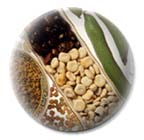- Home
- Introductions

|
Vegetable Seed Production: CucumberYou are here: Seed Production: Cucurbitaceae: Cucumber Botany Soil Nutrition Optimum growth of cucumbers requires soils with high organic matter and a pH of 6.5 or above. The organic matter is often supplied by green manure crops that are turned under before they reach maturity and become woody. It is difficult to provide a specific fertilization recommendation because of the diversity of soils on which cucumbers successfully grow. However, a fertilization regime of 1-2-2 is suitable before planting under non-irrigated conditions. Under irrigated conditions, the ratio should be 2-1-1 with half of the nitrogen applied a month after emergence to to replace that lost from leaching. Isolation Pollination Cucurbits require that pollen move from staminate to pistillate flowers or from the anthers to the stigma of perfect flowers. Honey bees are the msot reliable and cost-effective way to achieve pollination. One to two hives per acre are introduced when 5 to 10 percent of the plants have open flowers. If hives are placed in weedy areas or close to other flowering crops, the number of hives per acre should be increased. Hives should be placed in clusters around the periphery of fields, with additional hives placed inside of larger fields. F1 hybrids dominate the market for most commerical cucurbit crops due to their greater vigor, higher yield, and greater uniformity than open-pollinated varieties. In addition, since parent lines are proprietary and seed cannot be propagated for a second generation from hybrid seed, seed company investments in varietal research and development are more secure. Hybrid seed production is common for cucumbers and summer squashes and represents the bulk of seed produced for these crops. In hybrid cucumber production, genetic manipulation is used to grow plants having only female flowers (gynoecious plants). These plants will be hybrid "mother plants." Adjacent rows are planted with normal genotypes to provide pollen, and bees transfer the pollen from the male flowers to the female flowers. Planting The time of planting is delayed until the danger of frost is over. Because of the irregular, flat seed shape, most cucumber seed is coated so that precision planting can be accomplished. Direct seeding using drills into rows that are 91 to 122 cm (3 to 4 feet) apart at a rate of nine seeds per meter (three seeds per foot) is practiced. After emergence, the seedlings are thinned by cutting (pulling creates injury to the developing roots of the plant to be retained) to one plant per foot. When the initial vegetative leader stem has produced three to five leaves, it is removed by pinching to encourage growth of the remaining two lateral stems and their fruits. This results in the development of four or five fruits per parent plant.
Irrigation Cucumbers require high levels of water during vigorous vegetative and reproductive growth. Even in areas where rainfall is plentiful, periodic droughts substantially reduce yields and irrigation is necessary in these instances. While furrow irrigation is preferred, when overhead irrigation is used, it should be applied early in the day to permit the vegetation to dry out prior to nightfall and thereby minimize fruit rooting and foliar diseases. Roguing
Seed Harvest Fruit maturity affects seed quality in cucumber. For maximum seed quality, cucumber fruits must reach full maturity. This is signaled by a change in color from green to yellow and by a withering of the fruit stalk. Fruits can also be examined to determine seed maturity. Seeds that separate easily from the flesh of a sliced cucumber fruit are ready for harvest. At this stage, the fruits are typically harvested by hand and carried to a central seed extraction, drying, and storage facility for stock seed or small seed lots. For commercial seed, the plants are windrowed and then machine harvested. The slurry is augered into steel bins and then taken to the plant for seed extraction.
Seed extraction is accomplished by natural fermentation or acid treatment. In the former process, fruits are first sliced and macerated and the surrounding pulp, juice, and seeds allowed to ferment for about 4 to 6 days under normal field conditions. In the latter process, commercial hydrochloric acid (3 fluid ounces) or sulfuric acid (1 fluid ounce) added to and stirred with 11.3 kg (25 pounds) of the sliced, macerated fruit tissue. After 15 to 30 minutes, water is added to the mixture and the mature seeds sink to the bottom while the digested pulp floats to the top. Whether fermentation or acid extraction is used, the seeds must be immediately washed to preserve seed quality. This is done by collecting the seeds on screens and adding the seeds to water troughs with riffles as described for tomato seeds. The remaining pulp material and acid float off while the cleaned seeds are retained on the riffles. Cleaning After extraction, the seeds are immediately dried. This is done either in the sun with frequent stirring and turning of the seed or with artificial batch driers that have a rotary paddle to expose the seed to heated air. The initial drying temperature should not exceed 40°C (104°F) and the seed should be dried until it reaches a moisture content of 6% prior to cleaning and storage. Cucumber seeds may still contain slight amounts of fruit debris following drying. This can be removed by an air-screen machine. Light and immature seeds can be separated from mature seeds on a gravity table. Cucumber seeds stored at 6.5% moisture content under proper temperature and relative humidity conditions can remain viable for 5 to 7 years. Seed Yield Seed Identification:
|
||||||||||||||||||||